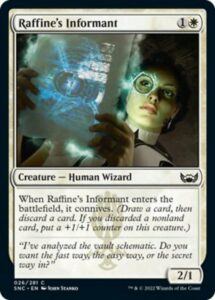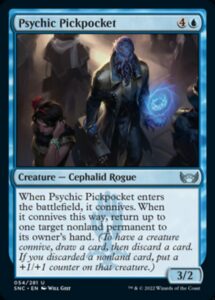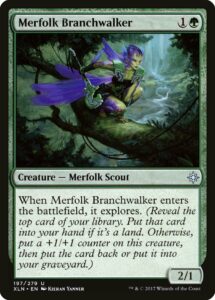As the brief Streets of New Capenna spoiler season kicked into gear, one mechanic stood out to me above the rest: Connive.

While distinct in critical ways, Connive harkens back to one of my least-liked mechanics since I’ve started writing about Magic design: Explore. Now, to be clear, I’m not saying Explore is bad; it isn’t, but it absolutely is not my cup of tea. That said, to talk about what I appreciate about Connive, we’ll need to first talk about what I didn’t like about Explore.
Merfolk Branchwalker is the obvious ancestor of Raffine’s Informant. They’ve the same stats, the same cost (with a change in color in creature type), and the same ability: when they enter the battlefield, they do the thing. Notably, Merfolk Branchwalker was an uncommon (and likely still would be today), while Raffine’s Informant is a common. This makes sense, since Explore has more powerful outcomes than Connive does. But I’m getting a bit ahead of myself.
Explore is a mechanic that balances power using randomness. Its two outcomes are powerful bonuses: either drawing a card (which adds about two mana to a card’s cost, maybe a bit less) or getting a +1/+1 counter and Surveil 1 (which adds about the same). However, Exploring tends to only cost one mana because you have minimal control over which outcome you get. The input is mostly random (you can’t often easily control the top of your deck, especially given how Explore only sets your deck for one turn) and the output is also mostly random (the only choice you get to make is to maybe Surveil 1). I accept that variance is both a necessary aspect of Magic and often a source of fun even to people who might think they dislike it, but also believe that variance isn’t ideal for balancing power level.
Ultimately, my biggest issue with Explore was with creatures like Siren’s Lookout and Queen’s Agent. Sure, there was a huge difference between Seekers’ Squire being a 1/2 and a 2/3, but you were ultimately getting a solid deal on both halves. However, when a creature has a keyword like Flying, Lifelink, or First Strike, the power of +1/+1 is greatly magnified.
A Siren’s Lookout that was a 2/3 Flying on turn 3 could dominate a game by itself, while a 1/2 Flying barely impacted the battlefield (despite drawing you a card). Similarly, a Queen’s Agent as a 4/4 could potentially catch you up in notoriously uninteractive Ixalan, while a 3/3 often wasn’t enough to blunt an assault (and was vulnerable to too much removal). I found those cards frustrating to play with and against—they added highly exposed randomness to justify the major delta in each overpowered (for its cost) mode. That feeling clearly seems to have influenced the design of Connive.

Connive is very much in dialogue with Explore. There’s still high randomness in input (you have limited control over the top of your deck), but an enormous amount of control over the output (you can craft a hand to guarantee the +1/+1 counter, should you want it) and greater consistency in output (you always loot). This decrease in randomness is matched by a decrease in power level—you will never go up a card, and you have to sacrifice a spell to earn a +1/+1 counter.
Conceptually, I’m all for these changes. It’s an interesting but relatively straightforward choice. It relies on agency to decide among moderately powerful options, rather than randomness to counterbalance overpowered options. I also appreciate the use of “when it connives this way” to provide enters-the-battlefields effects that can be (partially) stopped via removal spells. I love how it’s backwards compatible with mechanics like Madness and Delirium. It’s a bunch of choices that make me excited to play with the mechanic.
Still, it’s too soon to pass judgment on Connive. Not only have we not seen the full extent of cards bearing the mechanic, we’ve critically not yet had a chance to play with it. So, while I’m enthusiastic about Connive and what (to me) feel like improvements over Explore, for all I know it might make me appreciate elements of Explore I’ve overlooked or undervalued.
As a final note, Connive makes me curious about the color pie. Connive grants Looting (an ability traditionally only seen in blue) to white and black. This follows 2021’s Learn, which bled Rummaging (a red ability) into all four other colors. I don’t think either mechanic harms the color pie—each color already has access to card-smoothing mechanics like Scry and Cycling—but I wonder which other abilities that have been cordoned off to single colors will soon become fair game for other colors in the right environment. Magic is a hungry game that demands constant innovation, and perhaps this is a vein we’ll see tapped into more in the sets to come. Time will tell.
And, as always, thanks for reading.
Zachary Barash is a New York City-based game designer and the last commissioner of Team Draft League. He designs for Kingdom Death: Monster, has a Game Design MFA from the NYU Game Center, and does freelance game design. When the stars align, he streams Magic (but the stars align way less often than he’d like).




